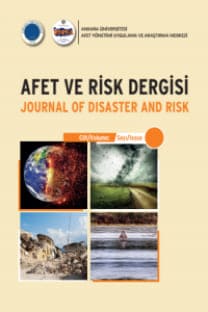The Use of Web GIS in The Rapid Evaluation Process of The Post-Earthquake Urban Building Stock
Damage Determination, Disaster Management, Geographical Information Systems, Rapid Evaluation, Risk Evaluation, Urban Geography
The Use of Web GIS in The Rapid Evaluation Process of The Post-Earthquake Urban Building Stock
Damage Determination, Disaster Management, Geographical Information Systems, Rapid Evaluation, Risk Evaluation, Urban Geography,
___
- Abdalla, R., Esmail, M. (2019). WebGIS techniques and applications. In WebGIS for Disaster Management and Emergency Response (pp. 45–55). Springer.
- Agrawal, S., Gupta, R. D. (2017). Web GIS and its architecture: a review. Arabian Journal of Geosciences, 10(23), 518. https://doi.org/10.1007/s12517-017-3296-2
- Akdemir, İ. O., Çağliyan, A., Dağli, D. (2015). Kentsel planlamada coğrafi bilgi: Elâzığ uygulaması. Fırat Üniversitesi Harput Araştırmaları Dergisi, 2(1), 53-76 Retrieved from DOI: https://dergipark.org.tr/tr/pub/had/issue/32297/358842
- Annen, A. (2005). Geostandards: Opengeospatial consortium ogc (gml, wfs, wms). Journées d’étude Interopérabilité Pour l’utilisation Généralisée de La Géoinformation, Standards Nationaux et Internationaux, Zürich, Suisse.
- Batty, M., Hudson-Smith, A., Milton, R., Crooks, A. (2010). Map mashups, Web 2.0 and the GIS revolution. Annals of GIS, 16(1), 1–13. DOI: https://doi.org/10.1080/19475681003700831
- Bildirici, İ. Ö., Kırtıloğlu, O. S. (2015). Google Maps API ile Etkili Kartografik Araçlar Oluşturmak. 15. Harita Bilimsel ve Teknik Kurultayı. Retrieved from https://www.hkmo.org.tr/resimler/ekler/9b9dda863a7a9ef_ek.pdf
- Çağlayan, N., Satoğlu, Ş. I., Kapukaya, E. N. (2018). Afet Yönetiminde Büyük Veri Ve Veri Analitiği Uygulamaları: Literatür Araştırması, 7. Ulusal Lojistik ve Tedarik Zinciri Kongresi, ULTZK, 3–5.
- Chow, T. E. (2008). The potential of maps APIs for internet GIS applications. Transactions in GIS, 12(2), 179–191. DOI: https://doi.org/10.1111/j.1467-9671.2008.01094.x
- Crampton, J. W. (2009). Cartography: maps 2.0. Progress in Human Geography, 33(1), 91–100. DOI: https://doi.org/10.1177/0309132508094074
- Çağlıyan, A., Dağlı, D. (2022). Monitoring Land Use Land Cover Changes and Modelling of Urban Growth Using a Future Land Use Simulation Model (FLUS) in Diyarbakır, Turkey. Sustainability, 14(15), 9180. DOI: https://doi.org/10.3390/su14159180
- Demirtaş, N., Şahin, H., Durucan, C. (2021). Betonarme Yapılarda Deprem Sonrası Yapısal Hasarların Tahmini İçin Kullanılan Hızlı Değerlendirme Yöntemlerinin Etkinliklerinin Belirlenmesi. Fırat Üniversitesi Fen Bilimleri Dergisi, 33(2), 125–134. Retrieved from https://dergipark.org.tr/en/pub/fufbd/issue/64918/872683
- Eisnor, D., Wilson, J. (2006). What is neogeography anyway. Platial News and Neogeography, 27. DOI: http://platial.typepad.com/news/2006/05/what_is_neogeog.html
- Fichter, D. (2010). What is a Mashup. In ENGARD, N. Library Mashups Exploring New Ways to Deliver Library Data (pp. 3–18). Retrieved from http://scholar.google.com/scholar?hl=enandbtnG=Searchandq=intitle:What+Is+a+Mashup+?#1
- Fu, P. (2015). Getting to know Web GIS. Esri Press Redlands, CA.
- Goodchild, M. F., Glennon, J. A. (2010). Crowdsourcing geographic information for disaster response: a research frontier. International Journal of Digital Earth, 3(3), 231–241. DOI: https://doi.org/10.1080/17538941003759255
- Haklay, M., Singleton, A., Parker, C. (2008). Web mapping 2.0: The neogeography of the GeoWeb. Geography Compass, 2(6), 2011–2039. DOI: https://doi.org/10.1111/j.1749-8198.2008.00167.x
- Law, D. (2014). Portal for ArcGIS 101. Http://Www. Esri. Com/Esrinews/Arcuser/Winter-2014/Portal-for-Arcgis-101 [May 23, 2016].
- Mansourian, A., Rajabifard, A., Valadan Zoej, M. J. (2005). Development of a web-based GIS using SDI for disaster management. In Geo-information for disaster management (pp. 599–608). Springer.
- Mete, M. O., Yomralıoğlu, T. (2021). Açık Kaynaklı Bulut CBS Yardımıyla Kitlesel Taşınmaz Değerleme Uygulaması. Harita Dergisi, 165, 28–42. Issn : 1300-5790
- Şahin, H., Alyamaç, K. E., Durucan, A., Demirel, B., Açıkgenç, U., Bildik, M., … Demir, T. (2020). 24 Ocak 2020 Mw 6.8 Sivrice/Elazig Depremi Elazig Bölgesi Yapısal Hasarlar İnceleme ve Analiz Raporu. DOI: https://doi.org/001
- Sieber, R. (2006). Public participation geographic information systems: A literature review and framework. Annals of the Association of American Geographers, 96(3), 491–507. DOI: https://doi.org/10.1111/j.1467-8306.2006.00702.x
- Sun, W., Bocchini, P., Davison, B. D. (2020). Applications of artificial intelligence for disaster management. Natural Hazards, 103(3), 2631–2689. DOI: 10.1007/s11069-020-04124-3
- Sürmeli, D. (2011). Yapay sinir ağları ile afet yönetiminde sosyal zarar görebilirlik riskinin belirlenmesi. Sakarya Üniversitesi. DOI: https://hdl.handle.net/20.500.12619/93286
- Tarhan, Ç., Partigöç, N. S. (2021). Web Tabanlı CBS Uygulamalarının Afet Riski Azaltmadaki Rolü. Resilience, 5(2), 265–279. DOI: https://doi.org/10.32569/resilience.1028577
- URL-1: Ministry of Environment and Urbanization and Directorate-General Urban Transformation Services, https://altyapi.csb.gov.tr/yonetmelikler-i-461. Last Access: 06.05.2022
- Wagner, J. (2015). How to Use APIs to Build GIS, Mapping and Location Applications. Retrieved from ProgrammableWeb website: https ://www.programmableweb.com/news/how-to-use-apis-to-build-gis-mapping-and-location-applications/analysis/2015/04/13
- Wu, X., Xu, C., Xu, X., Chen, G., Zhu, A., Zhang, L., … Du, K. (2022). A Web-GIS hazards information system of the 2008 Wenchuan Earthquake in China. Natural Hazards Research. DOI: https://doi.org/10.1016/j.nhres.2022.03.003
- Yigitcanlar, T., Desouza, K. C., Butler, L., Roozkhosh, F. (2020). Contributions and risks of artificial intelligence (AI) in building smarter cities: Insights from a systematic review of the literature. Energies, 13(6), 1473. DOI: https://doi.org/10.3390/en13061473
- Yüksel, İ. (2008). Betonarme Binaların Deprem Sonrası Acil Hasar Değerlendirmesi. Erciyes Üniversitesi Fen Bilimleri Enstitüsü Fen Bilimleri Dergisi, 24(1), 260–276. https://dergipark.org.tr/tr/pub/erciyesfen/issue/25577/269794
- Zergera, A., Smith, D. I. (2003). Impediments to using GIS for real-time disaster decision support. Computers, Environment and Urban Systems, 27(2), 123–141. DOI: 10.12691/jbms-8-1-3
- Yayın Aralığı: 4
- Başlangıç: 2018
- Yayıncı: Ankara Üniversitesi
Reflection of COVID-19 in The Context of Posttraumatic Growth in Turkish Society
Çağla YİĞİTBAŞ, Ayse ELKOCA, Handan ÖZCAN
Afet ve Acil Durumlara Müdahale Kapsamında Destek Personelin Hazır Oluşluğunun Artırılması
Emine GERCEK OTER, Gürkan YILMAZ, Halise ÇİNAR, Nadir Savaş ÖTER, Filiz ABACIGİL, Evrim ÇEVİK
The Use of Web GIS in The Rapid Evaluation Process of The Post-Earthquake Urban Building Stock
Orman Yangınları Sonrası Ekosistem Tabanlı Planlamaya Doğru: Yanma Derinliğinin Sınıflandırılması
Coşkun Okan GÜNEY, Ahmet MERT, Serkan GÜLSOY
Afet Eğitiminde Afetlere Hazırlık: Üniversite Öğrencileriyle Tehlike Avı
Afet Yönetimi Odağında Orman Yangınlarının Değerlendirilmesi
Tam Donanımlı Bir Hastanede Afet Ekibinin KBRN Farkındalığının Değerlendirilmesi
Ceren KAYNAK, Yusuf Arif KUTLU
Üniversite Öğrencilerinde Afet Farkındalık Eğitimi Etkinliğinin Değerlendirilmesi
